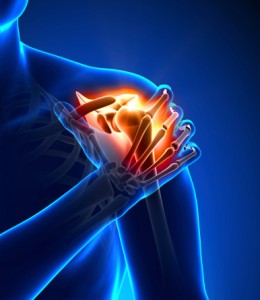
Article written by: Chris Wolfe, PT, Certified MDT, OCS
Director of Green Hills STAR Physical Therapy
www.StarPT.com
Shoulder disorders are some of the most common joint complaints, and shoulder impingement syndrome and rotator cuff tendonitis are considered to be the most frequent cause of shoulder pain and disability. The shoulder complex is unique in the body due to its structure and function. It is considered a ball and socket joint involving the large rounded end of the upper arm bone called the humerus and the small shallow socket of the shoulder blade. This disproportional shape allows for a wide range of directions that the arm can be moved; however, it does not provide much stability to hold it in place. The stability of the shoulder relies heavily on numerous ligaments, tendons and muscles; and the most common group is called the rotator cuff. The rotator cuff attaches to and surrounds the rounded end of the humerus and is bordered superiorly by a bony roof called the acromion. There is a small space between this bony roof and the rotator cuff. With reaching overhead, the space around the rotator cuff decreases, sandwiching and pinching the tendons between the two bones. This can lead to the disorder of shoulder impingement where the tendons become compressed and then inflamed.
Rotator cuff injuries
This type of painful compression may be secondary to tight and inflexible muscles, tendons and joints surrounding the shoulder and shoulder blade. It may also be due to significant weakness of the shoulder muscles creating an imbalance when the arm is moved overhead. Also, there can be a bony spur occupying space above the rotator cuff causing an abnormal pinching effect. When an injury occurs, despite the cause, the rotator cuff becomes inflamed and swelling occurs in the muscles and tendons. The swelling can lead to compression in the shoulder, shunting blood away from the muscles and possibly causing some fraying of the rotator cuff tendons , much like the fraying of a piece of rope. In this stage, the shoulder is typically described as achy at rest, and the pain complaints are felt in the front of the shoulder and on the side of the upper arm. This stage of inflammation can lead to further tightness of the rotator cuff and surrounding structures causing difficulty with reaching behind the back, pain with reaching overhead and noticeable weakness. If this impingement condition persists and worsens, it damages the rotator cuff to the point of forming an actual tear.
Treatment Options
Impingement syndrome can be treated in a variety of ways but usually involves a combination of approaches. The first mode of treatment is protecting the painful and inflamed rotator cuff from further damage and aggravation. Painful reaching motions should be avoided early on in the treatment process in order to protect against further damage. During this resting time, the shoulder inflammation and swelling needs to be reduces. This is usually accomplished with rest, ice and oral anti-inflammatories. If symptoms persist, despite the use of anti-inflammatory, a cortisone injection may be used. These steps will help reduce the symptoms but not solve the cause of the problem. If the actual cause of the problem is not addressed, the symptoms od pain and swelling will return. As the symptoms are reduces, the shoulder needs to be assessed for stiffness, loss of flexibility, along with the loss of strength and stability. Once this is evaluated, a treatment plan involving stretching and strengthening exercises needs to be prescribed and performed. Not all shoulders are created equal, so an individualized plan for treatment needs to be designed and instructed. Many times, there needs to be a certain amount of manual stretching and joint mobilizations provided from a trained and licensed Physical Therapist as well. The vast majority of people who suffer from shoulder impingement are treated successfully with these steps of rest, medications, stretching exercises and the temporary avoidance of overhead reaching. If symptoms persist or if there is significant weakness present that is not improving the rotator cuff may be damaged and require further assessment from an Orthopedic MD.
